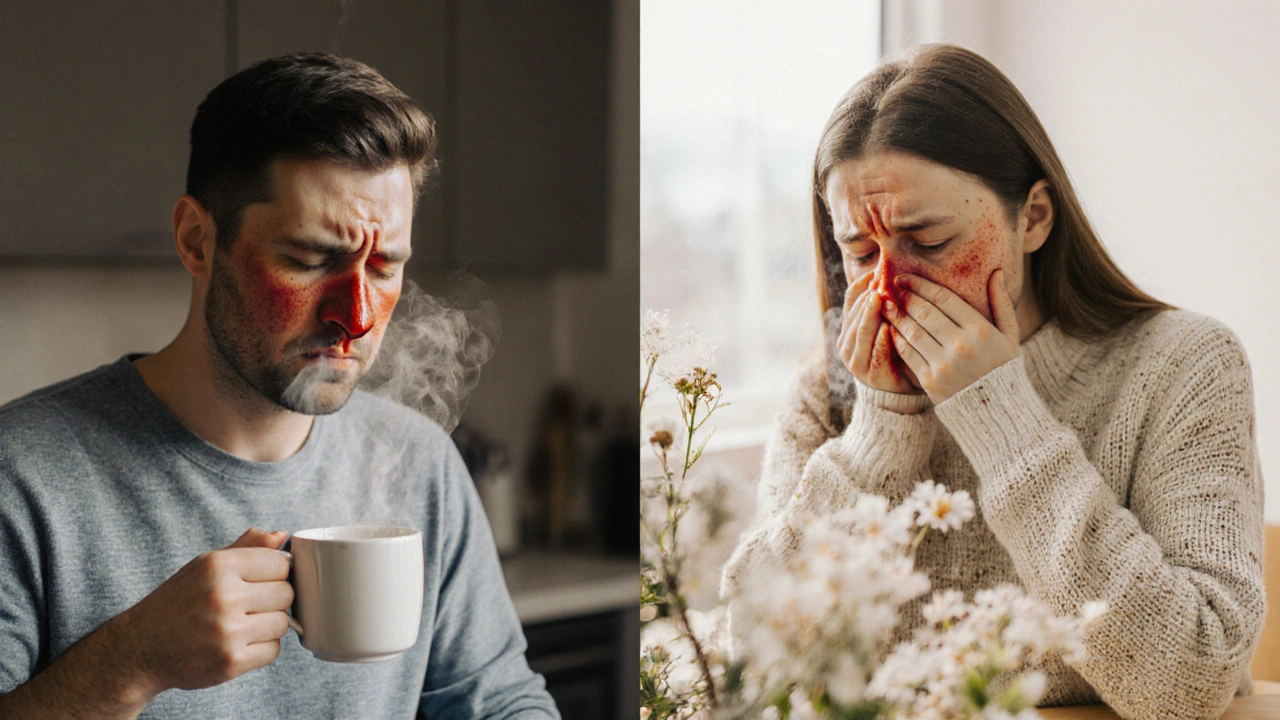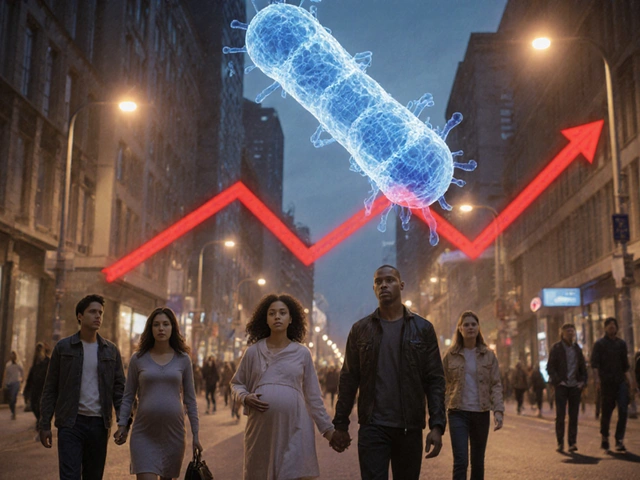Arunny nose can feel like a nuisance, but it’s also a clue about what’s happening inside your nasal passages. Whether it’s a viral cold, a bacterial sinus infection, or an allergic reaction, the mucus tells a story. Below you’ll find a step‑by‑step guide to read that story, decide if you’re battling an infection or an allergy, and act accordingly.
Quick Summary
- Infections bring fever, thick yellow/green mucus, and last 7‑10days.
- Allergies cause clear, watery discharge, itchy eyes, and flare with exposure to triggers.
- Key tests: temperature check, symptom timing, and simple home allergy provocation.
- Seek medical care if symptoms persist beyond two weeks, cause severe pain, or are accompanied by high fever.
- Self‑care: stay hydrated, use saline rinses, and match treatment (antihistamine vs. decongestant) to the cause.
Understanding the Runny Nose
Runny nose is a condition where excess nasal mucus is produced, often as a protective response to irritation or infection. The nasal lining contains nasal mucus, a thin fluid that traps dust, microbes, and allergens. When the body detects a problem, the lining ramps up mucus production to flush it out. The color, consistency, and accompanying symptoms give away the underlying trigger.
When an Infection Is Behind the Drip
Viral infection refers to the invasion of the upper respiratory tract by viruses such as rhinovirus, influenza, or coronavirus. A viral cold typically starts with a sore throat, then progresses to a runny nose and mild cough. Mucus may turn cloudy, then yellow or green as immune cells (especially neutrophils) accumulate. Fever is a common companion, ranging from 38°C to 39°C, signaling systemic inflammation.
Sometimes bacteria seize the opportunity after a viral bout, leading to a bacterial infection. Sinusitis caused by Streptococcus pneumoniae or Haemophilus influenzae often produces thick, purulent discharge, facial pressure, and pain that worsens when you lean forward.
Allergic Rhinitis: The Other Side of the Coin
Allergic rhinitis is an inflammation of the nasal mucosa triggered by allergens such as pollen, dust mites, or pet dander. The immune system releases histamine, a chemical that dilates blood vessels and stimulates mucus glands. The result is clear, watery discharge that often appears in a “double‑sided” stream.
Allergies bring extra cues: itchy, watery eyes, sneezing fits, and a tickle in the throat that doesn’t improve with rest. Symptoms are highly seasonal for pollen, but can be year‑round for indoor triggers like indoor allergens (dust mites, mold spores).
Spotting the Differences: Symptom Cheat Sheet
| Feature | Infection | Allergy |
|---|---|---|
| Mucus color | Clear → yellow/green | Clear, watery |
| Duration | 5‑10days (viral), up to 2weeks (bacterial) | Days to weeks, recurs with exposure |
| Fever | Common (38‑39°C) | Rare |
| Itchy eyes / throat | Uncommon | Frequent |
| Sneezing | Occasional | Frequent bursts |
| Trigger pattern | Often starts after exposure to sick person | Seasonal or indoor allergen exposure |
Use this table as a quick reference while you’re checking your own symptoms. Keep a simple diary - note the color of the discharge, any fever spikes, and what you were doing (e.g., gardening, staying indoors) when symptoms began.

Practical Self‑Assessment Steps
- Take your temperature. If it’s above 38°C, infection is more likely.
- Observe mucus. Thick, yellow or green suggests bacterial involvement; clear and watery leans toward allergy.
- Check for extra signs: itchy eyes, sneezing fits, or a rash. Those point to allergic rhinitis.
- Consider timing. Symptoms that flare in spring or fall often match pollen schedules. Persistent symptoms year‑round may be indoor allergens.
- Do a simple exposure test. Sit in a room with an open window during high pollen counts; if your nose starts running within minutes, allergy is probable.
If the first three steps point to infection but you have no fever, it could be a mild viral cold that will resolve on its own. If you suspect a bacterial sinus infection (painful pressure, lasting longer than 10days, or worsening after a week), see a doctor for a possible PCR test or culture to confirm the pathogen.
When to Seek Professional Help
While most colds and allergies can be managed at home, certain red flags demand medical attention:
- High fever (>39°C) lasting more than 48hours.
- Severe facial pain, swelling, or vision changes - possible sinus complication.
- Discharge that turns dark brown or blood‑stained.
- Difficulty breathing or wheezing, especially if you have asthma.
- Symptoms persisting beyond two weeks without improvement.
Healthcare providers may prescribe antihistamine for allergy relief or a short course of antibiotics if a bacterial infection is confirmed. They might also recommend a nasal corticosteroid spray for chronic allergic rhinitis.
Self‑Care Strategies That Work
Regardless of the cause, keeping the nasal passages moist speeds recovery. A saline rinse or neti pot flushes out irritants and thins mucus. Stay hydrated - water, herbal tea, and clear broths keep secretions fluid.
For infections, rest and over‑the‑counter pain relievers (acetaminophen or ibuprofen) manage fever and headache. For allergies, an oral antihistamine (loratadine, cetirizine) taken before exposure can blunt the reaction. If you’re outdoors during peak pollen, wearing sunglasses and a mask reduces airborne contact.
Related Topics You Might Explore Next
Understanding your runny nose opens doors to a broader health picture. You may want to read about:
- How to build an indoor air‑quality plan for allergy sufferers.
- Differences between a common cold and flu.
- When to use a humidifier versus a dehumidifier for sinus health.
- Nutrition tips that boost immune defenses during cold season.
All these topics sit under the larger umbrella of respiratory health, a key component of overall wellness.
Frequently Asked Questions
Can a runny nose be both an infection and an allergy at the same time?
Yes. It’s common for an allergic rhinitis baseline to become irritated by a viral cold, leading to mixed symptoms. In such cases, treat the infection first (rest, fluids) and keep antihistamines on hand for the allergy component.
How long should I wait before assuming my runny nose is an allergy?
If symptoms last longer than two weeks, are clear and watery, and you notice a pattern linked to seasons or indoor triggers, allergy is the likely culprit. A short‑term antihistamine trial can also confirm the diagnosis.
Do antibiotics help a runny nose caused by a virus?
No. Antibiotics target bacteria, not viruses. Using them for a viral cold won’t speed recovery and contributes to resistance. Reserve antibiotics for confirmed bacterial sinusitis.
Is it safe to use a decongestant spray for a week?
Over‑the‑counter nasal decongestant sprays (oxymetazoline) should not be used for more than three days. Prolonged use can cause rebound congestion, making the problem worse.
What home remedy works best for clearing mucus?
A warm saline rinse performed twice daily helps flush out allergens and pathogens. Pair it with steam inhalation (hot shower or bowl of hot water) to loosen thick mucus.







Cherish Capps
September 27, 2025 AT 13:06